Web Infantry Equipment, Pattern 1944
Web Equipment for the Age of Brushfire Wars
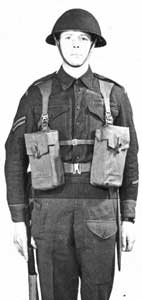 This Pattern had its origins in two requirements for lighter patterns of web equipment, one for temperate zones, the other tropical. The result appears to have been a convergence of these designs. In 1945, the course of the War changed, Germany collapsing more suddenly than was expected, leaving a war in the Far East. The newly designed pattern was then pressed into service for that campaign, which was envisaged as lasting until 1946. Two atomic bombs rather shortened that estimate. Pattern 1944 therefore became a “theatre issue”, for units serving in the Far East. It also doubled in the role of a “unit specific” Pattern, being routinely worn by Airborne troops and the Gurkhas, often in temperate zones. All this makes Pattern 1944 W.E. rather different to other Patterns, before or since and there’s even more to the story.
This Pattern had its origins in two requirements for lighter patterns of web equipment, one for temperate zones, the other tropical. The result appears to have been a convergence of these designs. In 1945, the course of the War changed, Germany collapsing more suddenly than was expected, leaving a war in the Far East. The newly designed pattern was then pressed into service for that campaign, which was envisaged as lasting until 1946. Two atomic bombs rather shortened that estimate. Pattern 1944 therefore became a “theatre issue”, for units serving in the Far East. It also doubled in the role of a “unit specific” Pattern, being routinely worn by Airborne troops and the Gurkhas, often in temperate zones. All this makes Pattern 1944 W.E. rather different to other Patterns, before or since and there’s even more to the story.
The War Office photo at left shows an early version of W.E. Patt. '44, made in khaki web with bright metal (probably brass) fittings. This picture is reproduced on page 233 of Brian Davis's British Army Uniforms & Insignia of World War Two, and is used with his gracious permission.
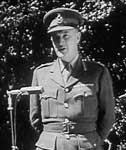 Military Mission 220, or The Lethbridge Mission
Military Mission 220, or The Lethbridge Mission
During 1943-4, Maj Gen John Sydney Lethbridge (1897-1961, shown right) led a team on a tour of Australia, Burma, Canada, Ceylon, China, Hawaii, India, New Caledonia, New Guinea, New Hebrides, New Zealand, Panama, Solomon Islands and the USA. In the course of this, the Mission gathered evidence and studied tactics and equipment requirements that would be necessary to defeat Japan in the Far East. Reports were prepared on these requirements, one of which was for a lightweight equipment for jungle warfare. However, this is only part of the story, since it does not allow for the existence of lightweight khaki and even white, webbing. These examples are marked 1944, earlier than examples of jungle-green Patt. ’44 W.E.
Lightweight Web Equipment Development
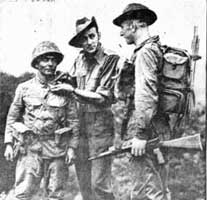 It is in the nature of all things that tests and trials can only go so far in reproducing service conditions, but the acid test is to try it “for real”. Patt. ’37 W.E. had now seen combat use, sufficient to at least show up other desirable requirements. The Basic pouches and Haversack were too small, the Mark VII bottle stopper leaked and the bearing surface of the Braces was too small. When assembled it could not be readily adjusted, especially when extra clothing was worn and it was ill-balanced. This last point is a little unfair, since Mills’ design - properly adjusted - is well balanced. Their design principles were completely negated by the Army’s slavish adherence to 19th Century military appearance. The Haversack was always worn high on the back, which meant the weight was taken directly by the Shoulder straps which, hooked to the Basic pouches, meant the Waist belt was pulled up, if not worn tightly. Mills had intended that the weight be taken by the under-arm (“Counter”, or “Kicking”) strap, which was attached at mid-chest, above the Basic pouches. Furthermore, the “Army Way” raised the same strap too high into the armpits, affecting both nerves and blood circulation, by compressing them.
It is in the nature of all things that tests and trials can only go so far in reproducing service conditions, but the acid test is to try it “for real”. Patt. ’37 W.E. had now seen combat use, sufficient to at least show up other desirable requirements. The Basic pouches and Haversack were too small, the Mark VII bottle stopper leaked and the bearing surface of the Braces was too small. When assembled it could not be readily adjusted, especially when extra clothing was worn and it was ill-balanced. This last point is a little unfair, since Mills’ design - properly adjusted - is well balanced. Their design principles were completely negated by the Army’s slavish adherence to 19th Century military appearance. The Haversack was always worn high on the back, which meant the weight was taken directly by the Shoulder straps which, hooked to the Basic pouches, meant the Waist belt was pulled up, if not worn tightly. Mills had intended that the weight be taken by the under-arm (“Counter”, or “Kicking”) strap, which was attached at mid-chest, above the Basic pouches. Furthermore, the “Army Way” raised the same strap too high into the armpits, affecting both nerves and blood circulation, by compressing them.
The photo above left is the earliest shot of Patt. '44 on action we've yet seen - taken from The War Illustrated No. 212, published 3 Aug 1945.
Lethern records that M.E.Co., “…at official request…”, had re-designed Patt. ’37 W.E. to be more lightweight. Unfortunately he does not record if this was for Europe. The fact that known lightweight items are in khaki and white, not green, would suggest that it was for the European theatre. Improving Patt. ’37 for a campaign, that was then of unknown duration, would seem sensible. Certainly, in 1943, it was a Second Front in Europe - not the Far East - that was occupying the attention of the Allied armies. Lethern does state that in December 1943 he had “…introduced a One-Piece Equipment to enable the Infantryman to carry all essential items of kit in addition to ammunition and bayonet, the idea being that it could be rapidly produced, be relatively cheap and actually be considered an expendible outfit primarily for jungle warfare in the Far East against the Japanese…”…”. The word “primarily” suggests it was a Private Venture of Mills, produced in anticipation of a need and produced before Lethbridge reported and not because of any requirement the Mission had placed. Both patterns were studied “…by the British Authorities…”. The Lethbridge Mission were reporting after March 1944, leaving little time for the evident development that took place. This puts M.E.Co.’s One-Piece Pattern ahead of any Lethbridge requirement, so its existence was fortuitous, as was that of the Lightweight Patt. ’37.
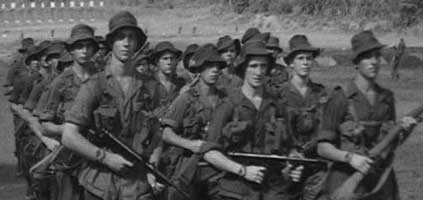 Unfortunately, nothing is known of Mills’ One-piece Pattern, though it could be inferred that this was on the lines of Rivers-Macpherson’s Battle Jerkin, which had appeared in 1942. Lethern’s use of words like “cheap” and “expendible” does not square with any of their usual products, lightweight, or not. It had to have been in something like canvas. Has any reader seen any photograph, or account that might shed further light? Lethern goes on to say the One-Piece Pattern was subjected to “…suggestion after suggestion…”, with the result that it became “multi-piece”! It is at this point that Lethern states that it was “…vat-dyed jungle-green and rot-proofed, having fittings of alloy anodised…”. This last point is also significant, as the khaki webbing had brass furniture.
Unfortunately, nothing is known of Mills’ One-piece Pattern, though it could be inferred that this was on the lines of Rivers-Macpherson’s Battle Jerkin, which had appeared in 1942. Lethern’s use of words like “cheap” and “expendible” does not square with any of their usual products, lightweight, or not. It had to have been in something like canvas. Has any reader seen any photograph, or account that might shed further light? Lethern goes on to say the One-Piece Pattern was subjected to “…suggestion after suggestion…”, with the result that it became “multi-piece”! It is at this point that Lethern states that it was “…vat-dyed jungle-green and rot-proofed, having fittings of alloy anodised…”. This last point is also significant, as the khaki webbing had brass furniture.
It is therefore felt that the Lethbridge requirements merely coincided with what was already happening. From 1945, Patt. ’44 sets were made in green, the official Standard Colour Chart shade being “S.C.C. 19”. This was to match the Jungle Green clothing already in service. It is interesting to note that, in 1944, the U.S. Army had introduced an Olive Drab #7. This was really just green webbing and was being worn in the E.T.O. (European Theater of Operations). If not the colour, there was certainly an American influence with the designs of the 18-inch Machete, Waterbottle carrier, Water bottle and Cup, quite apart from Mills first use of “hanger” hooks on a British design. To be fair, the outdated Bottle, water, enamelled, Mark VII was overdue for replacement by something better, as was its difficult-to-use Carrier. In 1944 the U.S. Army had commenced wearing webbing in Olive Drab Shade #7 – in other words, green and this was for the European Theatre.
The Fitting Instructions, issued only in 1946, state that it was “…first designed for use in the tropics, but has proved equally suitable for all conditions of modern warfare…”. This, in a War Office publication, is actually not true. In point of fact, it was War Office policy – in 1945 - that Patt. ’44 was to be a General Service pattern and was to replace Patt.’37. That same policy stated that when future orders for web equipment were placed, they should be for Patt. ’44 equipment and that Patt. ’37 pattern equipment would not be produced, except in small quantities, on a maintenance basis to match stocks. It was felt that the change-over to Patt. ’44 would not commence until approximately 1949. As examples of both Patterns clearly show, the reverse was actually the case. More importantly, every Plate in the Fitting Instructions shows khaki webbing and with bright metal fittings, probably brass. The one exception is the Rucksack, which is definitely green. By this time, the Bergen Rucksack was being made in green rubberised material, so the ’44 Rucksack was not bucking the trend on bulk load carriers.
With the rapid collapse in Europe, there were now quantities of un-used Patt. ’44 and only the Far East remained. Thus - and without full (any?) trials - Patt. ’44 W.E. was to be pressed into use in the Far East. Churchill notes that the war with Japan could last no less than 18 months after March - May 1945, i.e. to the end of 1946. In the event, the “nuclear solution” swiftly brought the war to a close, making large scale production unnecessary. The Ministry of Supply were then informed there would be no requirement for ’44 Pattern in the foreseeable future. Whilst the Pattern saw no actual wartime service, Airborne troops in Norway, after the German surrender, were wearing Patt. ’44 – in green.
POST-WAR TRIALS
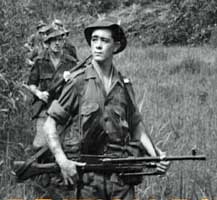 The War over, an examination of Patt. ’44 began in earnest. The first hint of dissatisfaction came from the User Trial Establishment, India. Early in 1946, they reported that the rate of sweating was increased in men wearing Patt.’44. This was felt to be caused by the waterproof lining on the Haversack. The War Office requested the R.A.O.C. Field Test Centre to carry out physiological trials, under controlled tropical conditions. The F.T.C. trials were carried out on three men, who were first acclimatised to hot, wet conditions over a thirteen day period. Wearing jungle clothing, they were tested over 2 hour periods in a Hot Room, alternating between Rest and Work. The latter consisted of stepping up and down on a one foot high stool, twelve times per minute. They were tested wearing Skeleton, Battle and Marching Orders of both patterns and the Patt. ’44 Haversacks were both with and without linings. Whilst there were differences in the sweat rate, they were small and F.T.C. concluded that there was no significant difference between the two patterns, nor between lined and unlined Patt. ’44 Haversacks. The results were at variance with U.T.E.I., who had not fully controlled either conditions, or the type of clothing worn. One of U.T.E.I.’s results had a lower sweat rate with the Patt. ’37 Pack than with the Patt. ’44 Haversack, despite the larger area of the back covered by the former. It was suggested that U.T.E.I. repeated their trials, but for the moment F.T.C. could not order the removal of the waterproof lining, which remained throughout the period of service of Patt. ’44.
The War over, an examination of Patt. ’44 began in earnest. The first hint of dissatisfaction came from the User Trial Establishment, India. Early in 1946, they reported that the rate of sweating was increased in men wearing Patt.’44. This was felt to be caused by the waterproof lining on the Haversack. The War Office requested the R.A.O.C. Field Test Centre to carry out physiological trials, under controlled tropical conditions. The F.T.C. trials were carried out on three men, who were first acclimatised to hot, wet conditions over a thirteen day period. Wearing jungle clothing, they were tested over 2 hour periods in a Hot Room, alternating between Rest and Work. The latter consisted of stepping up and down on a one foot high stool, twelve times per minute. They were tested wearing Skeleton, Battle and Marching Orders of both patterns and the Patt. ’44 Haversacks were both with and without linings. Whilst there were differences in the sweat rate, they were small and F.T.C. concluded that there was no significant difference between the two patterns, nor between lined and unlined Patt. ’44 Haversacks. The results were at variance with U.T.E.I., who had not fully controlled either conditions, or the type of clothing worn. One of U.T.E.I.’s results had a lower sweat rate with the Patt. ’37 Pack than with the Patt. ’44 Haversack, despite the larger area of the back covered by the former. It was suggested that U.T.E.I. repeated their trials, but for the moment F.T.C. could not order the removal of the waterproof lining, which remained throughout the period of service of Patt. ’44.
A trial was organised in Palestine in 1946, over a period of 5 months, with 6th Airborne Division. As an aside, the late Richard Todd, who passed away in December 2009, was serving as an officer with the Division. Dropped into Normandy, on the night of D-Day, he later won more lasting fame as an actor in such as The Dam Busters and The Longest Day. The Division experienced numbers of faults and deficiencies. In fact, very few of the items escaped comment:-
Waistbelt - eyelets worked loose; the main belt buckles were prone to becoming un-fastened; the fabric was too flexible, causing pouches to work loose when crawling
Basic Pouches – the belt hooks distorted too easily, allowing the pouches to come off the belt; the Q.R. fastener tabs became dog-eared and difficult to insert in the staples; the sides of the lids rucked up, allowing Sten magazines to be lost.
Water Bottle Carrier – the hanger hooks bent, or broke off; it was too low slung, allowing the bottle to bump into the wearer’s hip.
Haversack – the blanket straps were too short; Q.R. fastener tabs failed, as with the Basic pouches.
The Chief Inspector of Stores requested two modifications (a) the Haversack blanket straps were lengthened by 4 inches and (b) the hanger hook on the Water bottle carrier was made of heavier, 8 S.W.G. wire. The F.T.C. then carried out its own tests, which confirmed the Airborne criticisms, but also found additional faults:-
Basic Pouches - staples of the Q.R. fastener bent, so that the lid could not be secured
Haversack - increased strap length allowed carriage of jungle blanket and groundsheet together, but the Q.R. buckles on the Shoulder straps slipped, allowing the Haversack to drop lower
Water Bottle Carrier - heavier gauge wire solved the breakages, but to avoid bumping, it was recommended that the belt loop be used, rather than the hanger
Machete Scabbard - hanger hooks (still of thinner gauge) bent, or broke
F.T.C. recommended that the belt buckle should be made deeper; that all Q.R. securing tabs should be tipped with a metal, or plastic tongue; all hanger hooks to be of 8 S.W.G. wire and Q.R. buckles on the Shoulder straps should have serrated surfaces to achieve a better grip. Further sets were modified, resulting in three sets each of Prototypes A and B being sent for trial. These had certain common features that had been previously recommended, together with detail differences between the prototypes.
The trial took place over 22 days in April 1947, but was not reported until March the following year. Although many of the original faults had been rectified, “…many more had now developed…”. The modified belt buckle was now difficult to undo, but at least the eyelets did not work loose. There was no discernible difference in the rigidity due to the different weaving techniques of the belt webbing. The metal tipped securing tabs functioned well and the doped version remained perfectly rigid. Unfortunately the secondary tab (used to tug the tab out of its staple) broke off on half the Pouches used, the stitching effectively forming a perforated, tear-off tab! Both types of side panel on the pouch lids functioned well, with Pattern B wearing better. The Pouches still came off the belt as their original gauge wire belt hooks bent open. There was little difference in the grip between old and modified new Q.R. buckles, but now the large Haversack hooks that connected the strap to the Pouch were bending open! Surprise, surprise, halved hanger hooks meant the Prototype B Water bottle carrier came off when crawling. On the Shoulder straps, the sheradised tips were easier to insert than the standard, though no reason was given, but steel does bend less easily than aluminium. Finally the new 8 S.W.G. hanger hooks did not fail. All in all, not a conclusive result.
 The net result was a finding that Patt. ’44 was inferior to Patt. ’37 in durability and for general use. Patt. ’44 (modified), even without the bottle carrier and machete scabbard, was now as heavy as Patt. ’37! The F.T.C. recommendation was that sets of Patt. ’37 should be made up with modifications derived from Patt. ’44, namely doped tips, or sheradised steel tips and also that a chest strap should be added. No other detail is mentioned on this last item, such as the addition of loops on the Basic pouches for the chest strap.
The net result was a finding that Patt. ’44 was inferior to Patt. ’37 in durability and for general use. Patt. ’44 (modified), even without the bottle carrier and machete scabbard, was now as heavy as Patt. ’37! The F.T.C. recommendation was that sets of Patt. ’37 should be made up with modifications derived from Patt. ’44, namely doped tips, or sheradised steel tips and also that a chest strap should be added. No other detail is mentioned on this last item, such as the addition of loops on the Basic pouches for the chest strap.
The closing comments queried whether there should be further modifications, or should the whole question of P.L.C.E. be re-examined, “…with the possible complete elimination of web equipment in its present form…”. It is interesting to note Infantry Bulletin No. 44, issued in June 1947, is shown to be wishful thinking. The F.T.C. had already found the pattern wanting in March 1947, but the School of Mountain Warfare, in occupied Austria, were still reporting on Patt. ’44 in 1948.
In February 1949 a lengthy Report was prepared on Web Equipment, pack frames and framed packs. A brief history of Patterns ’37 and ’44 was set out, with reference to the Lethbridge Mission in the Far East. Mention was made of a long-term research project on P.L.C.E., for which a Policy Statement was being prepared. In the interim the short-term measure was to provide a set of P.L.C.E. incorporating, if possible, the best features of existing equipment, though some of those listed are new items. This was to draw upon the Patt. ’37, three versions of Patt. ’44 (including its Rucksack), a new pattern of Cold Weather Warfare webbing, the existing Bergen Rucksack and one other new design, the Battle Jerkin, two forms of Packboard, the existing Manpack Carrier and two derivatives of this last. Of these, Patts. ’37 and ’44 continued in service, together with the Bergen Rucksack and Manpack Carrier. All the rest fell by the wayside.
Whilst it is not known what became of these tests and recommendations, some light can be shed on the subject. Firstly, manufacture of Patt. ’37 re-commences in about 1953. All the metal fittings were Bonderised steel (a black coating), including Q.R. fasteners on all the Basic pouches, in place of press studs. On Patt. ’44, further manufacture took place, with dates noted from 1952 onwards, through into the 1960’s. As units had continued to use Patt. ’44, perhaps items were already unserviceable and required replacement. The Malayan Emergency had commenced in 1948, requiring issue of the “as manufactured” pattern for this theatre.
The balancing act between stocks held, a “wish list” and funding had probably mitigated any development. It ought not to be that stocks had run down by the 1960s, since so much mint 1945 dated items are still to be found. The pattern was far less durable than Patt. ’37, the belt taking the most wear, as it was often worn on its own. Thus a heavier belt was eventually introduced, but in only the mid 60’s. With it came a much larger Haversack and Basic pouches that could be worn high, or low on the belt. When the Confrontation (it was almost a secret war) flared up in Borneo in the 60’s, there was now a reason to incorporate the improvements established years prior, plus some new ideas. It has to be observed that the larger Haversack was clumsy, unless packed full. There was a huge void under a much larger flap, but above the weather flaps, which had to be filled, otherwise the flap did not close properly. The flap was also well equipped with extra “C” clips and loops, for even more equipment to be attached outside. The Shoulder straps were still attached in the original position, with no account taken of the great increase in Haversack height above that point of attachment. The new Haversack therefore sagged away from the body at the top. Pattern 1944 W.E. was finally made obsolete between 1991 and 1993, vanishing between those issues of the Catalogue of Ordnance Stores and Ammunition (COSA).